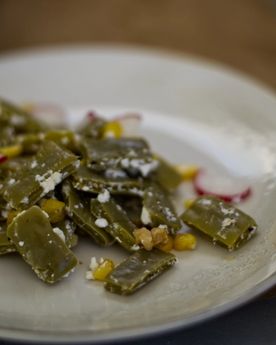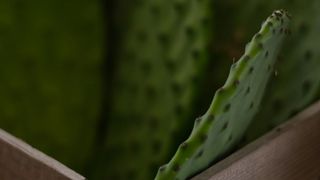If you enjoy this article, or any other content from this website, please subscribe to the newsletter. Your support can make a big difference!
I know what you're thinking.
You would never EVER consider eating prickly pear cactus leaves (officially known as cactus pads) because well, let's face it, no one has really dared to eat them.
That is — in Malta.
Can you eat Cactus Pads?
My first encounter with cactus pads was in Mexico. I was visiting for work and had the fortune of meeting a PhD student who was willing to introduce me to all things Mexican. I owe it to him for introducing me to a Mexican dish called Ensalada de nopales — literally meaning 'cactus salad'. I remember being both delighted and sceptical but I was completely won over when I tried it. Not unlike southern Mediterranean countries, cactus is just about EVERYWHERE in Mexico. The cactus pad is a vegetable that has been a staple in Mexican cuisine for centuries.
I couldn't believe that I had been driving past kilometres of prickly pear plants in Malta not ONCE thinking.
Hey! These could be edible!
All this time, we've been completely preoccupied with prickly pears — the cactus fruit. Regarded as a superfood in the Americas, foraging and harvesting prickly pear cactus leaves would not only be sustainable, but extremely nutritious as they grow throughout the Maltese islands.
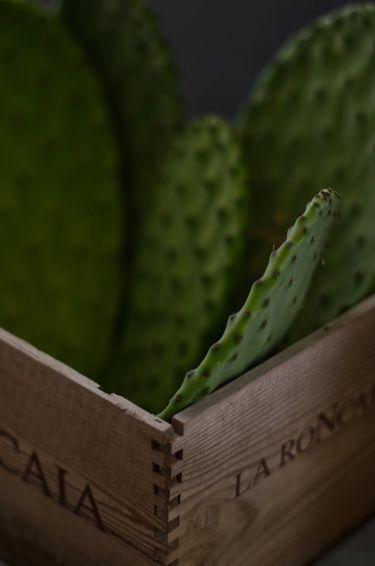
Cactus Pads Nutrition
Cacti are not just fascinating (and at times, painful) plants that produce beautiful flowers and delicious fruit.
The edible cactus pads, when cooked, taste similar to green beans but more lemony and their texture is similar to okra.
The cactus pads themselves are low in calories but rich in vital phytochemicals and antioxidants. 130 grams (1 cup) of cooked cactus has less than thirty calories, and less than five grams of carbohydrates — three of which are from fibre and less than two from natural sugar. This makes cactus a food that people with diabetes can include in their diets without fear of it causing high blood sugar levels. It also provides a quarter of your daily calcium needs and about 15% of your daily vitamin C needs.
Foraging for Cactus Pads
If you're actually asking yourself what variety of cactus can you eat, I'd like to put it straight. Don't go eating that cute little cactus you got as a wedding favour, k.
If you don't have the fortune of having a prickly pear cactus, make sure that you pick wild cactus plants that are off major roads (due to pollution) and also make sure that they aren't plants that belong to someone, as they often spill over the walls of private property.
Here are four tips for foraging the perfect cactus pads without needing to go to the polyclinic for cactus spine invasion.
- Wear thick gloves or use a long pair of tongs, as the spines are extremely irritating if lodged in the skin.
- Pick young stems that are approximately the size of an adult hand and half an inch thick. Bright green and bendy cactus pads will be the most flavoursome and succulent, and they will have fewer spines. Thicker, older pads have a thicker sap, which many people find have an unpleasant taste.
- Cut the prickly pear cactus pads with a sharp paring knife. Be sure to leave an inch of the stem behind for it to re-sprout. Cutting is preferable to twisting off; it is less stressful to the plant and helps keep the plant healthy.
- Collect the prickly pear cactus pads into a large container or even wrap them in the newspaper.
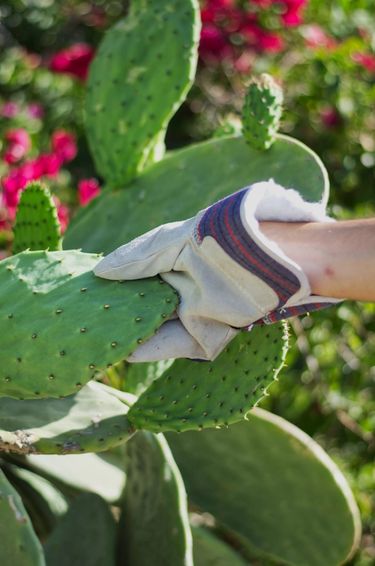
How to Remove the Spines
I can't emphasize this enough: protect your hands by wearing gloves!
- Knife: this is the most common method. Hold the cactus pad from the stem end and force the knife against the grain to remove the spines. That's my method.
- Potato peeler: Peel the pads with a potato peeler to remove all the spines. Rinse thoroughly
- Blow-torch or flame: Another method of preparing the pads is to burn off the spines with a blow-torch or over a flame using the tongs.
Whichever method you choose, make sure you double-check carefully to make sure you haven't missed any spines, because they won't miss you.
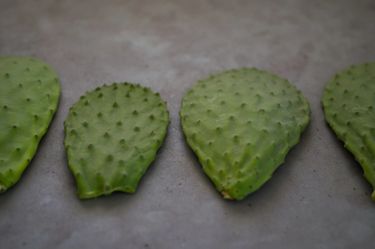
How to Store Fresh Nopales
If you are not using them immediately, you may store them in the fridge. Wrap them tightly in large beeswax wrap and refrigerate for up to two weeks.
How to Cook Prickly Pear Cactus Pads
The prickly pear cactus pads may be used in a variety of nutritious dishes, including salads, stews, omelettes, casseroles, and tortillas. They may also be simply pickled in brine and used as a condiment. The possibilities are near limitless!
But if you're lazy and don't dream of cooking, can you eat prickly pear cactus raw? Yes, you can but you won't like it. The uncooked cactus pads have a jelly-like liquid that’s similar to aloe vera and can taste quite bitter. However, I ain't stopping ya.
In terms of cooking preparation, the pads may be boiled, grilled, steamed, or sauteed.
- Boiled: When boiling the pads, you may have to change the water and re-boil a few times. The sap that comes from the pad may be thick. As a guide, the thicker the pad, the thicker the sap. After boiling, drain off the sap and rinse the pads in cold water. To eliminate the slime, boil the cactus pads in water twice. It is also said that adding onion and garlic to the pot will remove the slime. I have yet to try it.
- Grilled: When grilling, season well with salt and pepper. The pads are ready when they are slightly brown in colour and tender to the touch. They could also be seasoned with a little olive oil, a squeeze of lime juice, and a little salt.
- Sauteed or steamed: Sauteeing and steaming also work well for cooking the prickly pear cactus pads.
How you are using this vegetable will determine whether you leave the pads whole or cut them into strips or cubes. If you are cutting them, wipe the knife after each cut on kitchen paper.
Making Prickly Pear Cactus Pads Salad
For this recipe, all you will need are the following ingredients:
- Cactus leaves or pads — remember to pick the young leaves. These appear more vivid in colour and are bendier than their older siblings.
- Feta cheese — if you're vegan, replace this with vegan cheese
- Radish — fresh, bright radishes will have crisper flesh
- Fresh corn for grilling — I like to buy these with the husk (because they're pretty, ok!) but this will need to be removed for grilling
- Olive oil
- Lemon
As for the preparation, here are the following steps:
- I cut the cactus pads into 2.5cm strips (1 inch), boil the strips and then sautee them to season further.
- Whilst the cactus is boiling, don't forget to pre-heat the oven and begin cooking the ears of corn.
- The only other thing that requires preparation is the lemon vinaigrette. I use a simple concoction using equal parts of lemon and oil but feel free to adjust.
- The rest of the recipe requires no effort. Just mix everything together!
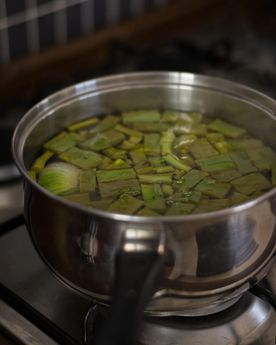
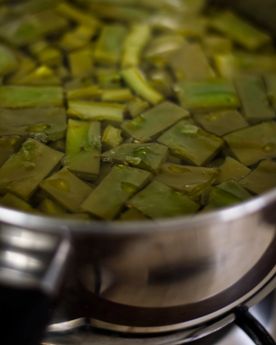
Prickly Pear Cactus Pads Salad
6 reviews
Description
A Nutritious Prickly Pear Cactus Pads Salad with a Lemon Vinaigrette
Information
- Servings
- 2persons
- Preparation time
- 20minutes
- Cooking time
- 40minutes
Ingredients
- 500gryoung prickly pear cactus leaves, spines removed and cleaned
- 150grcrumbled feta
- 50grthinly sliced radish
- 2ears of corn
- 15mllemon juice
- 30mlolive oil, plus extra for brushing the ears of corn
- —salt and pepper, to taste
Method
1. Cleaning the prickly pear pads
Once you've selected the young, bendy, and bright cactus leaves, you'll need to clean them. This may be the most frustrating part unless you have a knack for swishing knives.
First, you'll want to wear your gloves (a thick pair and not your regular cleaning gloves). You'll then need to grab the pad from the stem and position the knife against the grain in order to remove the spines together with the bumps that host the spines. Do this in a place where you can easily collect the spines without trouble.
Once you're done, give the pads a good wash.
2. Cooking the prickly pear cactus pads
Place a pot of water on the stove and bring to a boil, adding a hefty pinch of salt. Slice the cactus pads into 2.5 cm (1 inch) pieces and add these to the pot. Boil for about 15-20 minutes, or until tender. When tender, drain well.
Then place a medium skillet over medium-high heat and add in a bit of oil — not too much. Add the sliced prickly pear cactus pads and a pinch of salt (to taste) and cook for a couple of minutes.
Cover with lid and reduce heat to medium. Let cook and sweat about 20 minutes, or until the goo has seeped out and dried up.
3. Grill the corn
Preheat the oven to 190 C (375F) on the fan setting. Remove the silk hairs and the husk of the corn and brush olive oil over the corn. Wrap each ear of corn in a 6-inch piece of aluminium foil and cook for 30 minutes directly on the grill rack. Once ready, let the ears of corn sit for 5 minutes and then shred them into pieces, with a knife.
4. Prepare the lemon vinaigrette
In a small bowl, whisk together the lemon juice, salt and pepper.
Drizzle in the olive oil while whisking and continue to whisk until the dressing is emulsified.
5. Assemble the salad
Add the crumbled feta, thinly sliced radish, grilled corn, and the prickly pear cactus pads. Add the lemon vinaigrette and mix well. Serve as a main or side.
So, are you brave enough to try? I really hope so. If we create a big enough demand, we may be seeing cactus pads being sold on street curbs, cleaned of their spines, and sliced on the spot. Now wouldn't that be something!

